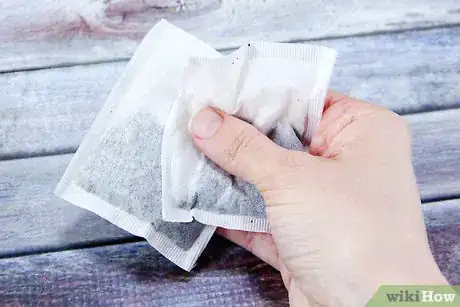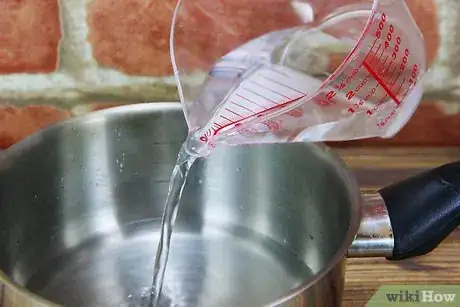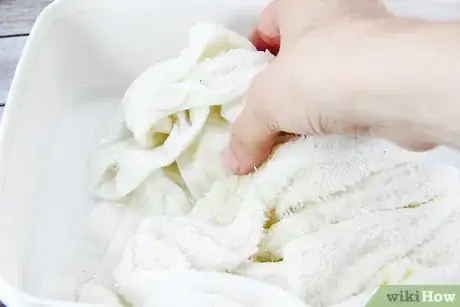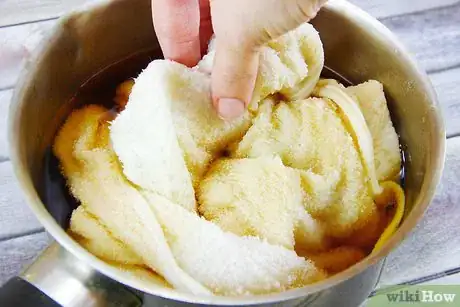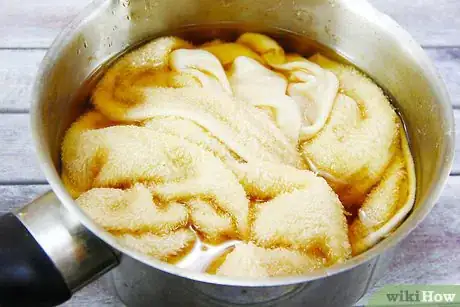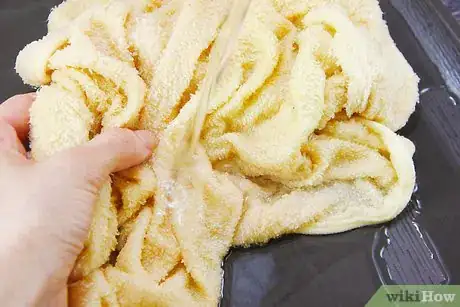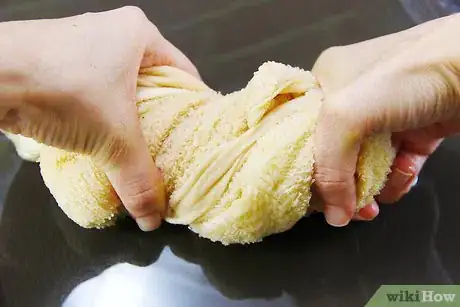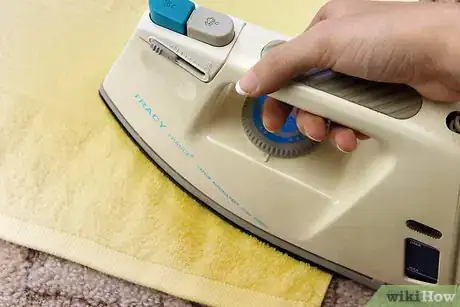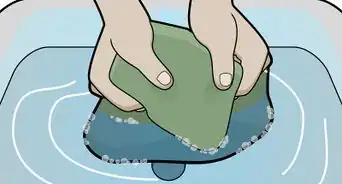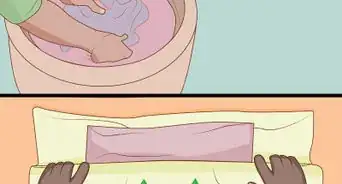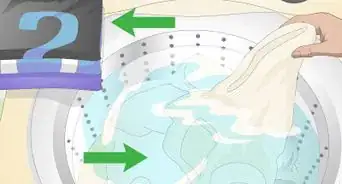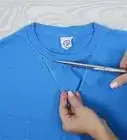This article was co-authored by Alina Bokovikova. Alina Bokovikova is a Costume Designer from California. With over 15 years of experience, she specializes in designing costumes for stage productions. Alina earned an MFA in Costume Design from the University of California, San Diego and her Master of Education from the Novosibirsk Pedagogical University. She’s won two Outstanding Costume Design awards and her costumes have been displayed in Moscow, Prague, and San Jose, California.
wikiHow marks an article as reader-approved once it receives enough positive feedback. In this case, 80% of readers who voted found the article helpful, earning it our reader-approved status.
This article has been viewed 329,729 times.
Dyeing with tea is an easy, inexpensive way to change the look of kitchen towels, tee shirts, or any fabric item. While the tea doesn't cause a drastic color change for white fabric, it can help hide light stains and give clothing a vintage look. Best of all, as long as you can boil water, you'll be able to dye any fabric with tea.
Steps
Steeping the Tea
-
1Remove the tea bags from their packaging and cut off the strings. To prepare the tea, unwrap the tea bags and discard the packaging. Use a pair of scissors to remove the strings, and throw those away as well.[1]
- Black tea works best for dyeing fabric because it has the deepest color. Teas that are light in color, such as white or green teas, don't work as well.
- You can also use loose tea to dye your fabric if you prefer. However, keep in mind that the process is less messy if you use tea bags.
- The number of tea bags that you’ll need depends on how large the fabric you’re dyeing is and how dark you want the fabric to become. You need to use enough water to cover the fabric, so the more water that you use, the more tea bags you’ll likely need.
- In most cases, you can assume that you’ll need one tea bag for every cup or 237 milliliters (8 fl oz) of water that you’re using. Keep in mind that you’ll want to add extra bags if you want your fabric to be a darker color.[2]
-
2Boil a large pot of water with salt in it. Fill a large pot with enough water to cover your fabric and allow it to move freely. Mix in some table salt, and place the pot on the stove.Turn the heat to high, and bring the water to a full boil.
- In general, you’ll want to use 4 cups or 1 liter (0.26 US gal) of water for every yard or meter of fabric that you’re dyeing.[3]
- Adding the salt to the water will help set the color in the fabric so it won’t come out as easily when you wash the items.
- Use 2 tablespoons of salt for every 4 cups or 1 liter (0.26 US gal) of water that you’re using.
Advertisement -
3Allow the tea to steep in the water. Once the water comes to a boil, remove the pot from the heat, and place the tea bags inside. Let the them soak in the water until the color comes out of the tea. In most cases, you’ll want to allow the tea to steep for at least 15 minutes.[4]
- The longer that you allow the tea to soak, the more color will come out and the darker your dyed fabric will be. Keep checking on the water to see if you’re happy with the color before you add the fabric.
Submerging the Fabric
-
1Wash or wet the fabric. The fabric that you’re dyeing should be wet when you dye it. Wash pre-used fabric to remove any stains or dirt. If you’re using new fabric, rinse it in water before dyeing. Be sure to wring out the fabric before dyeing it.[5]
- Tea dyeing will only work on natural fibers, such as cotton, silk, linen, and wool. It won't work on synthetic fabric, such as polyester.
- While you should wring out the fabric before dyeing it, don’t allow it to dry completely.
-
2Remove the tea bags and add the fabric. When your tea has reached the desired color, carefully lift all of the tea bags from the water and discard them. Place the wet fabric in the tea water, making sure that it’s completely submerged.[6]
- It may help to swirl the fabric around with a wooden spoon or other stirring instrument to ensure that it rests at the bottom of the pot and completely under the water.
- Some areas of the fabric may start popping up in the water. Use other spoons or kitchen tools to hold the fabric down.
-
3Soak the fabric in the tea for at least an hour. Once all of the fabric is submerged in the tea bath, allow it to soak for at least 60 minutes. Keep in mind that the longer that you leave the fabric in the tea, the darker it will be dyed.[7]
- To ensure that the fabric is dyed a very noticeable color, you may want to soak in the tea overnight.
- It’s a good idea to gently stir or agitate the fabric in the tea bath every so often while it’s soaking. That will help ensure that it dyes evenly.
- You can lift the fabric out of the tea at regular intervals to see how dark it has become. However, be aware that the fabric will dry lighter than it appears when wet so you may need to continue soaking it longer than you might think.
Rinsing and Drying the Fabric
-
1Rinse and soak the fabric in cold water and vinegar. Once you’re happy with the fabric’s color, remove it from the tea bath. Give it a quick rinse in cold water, and then allow it to soak for 10 minutes in a pot of cold water. Add a splash of vinegar to the water to help set the color.[8]
- If you’re bothered by the tea scent of the fabric, you may want to handwash it with laundry detergent meant for delicate items to remove the smell.
-
2Wring out the excess water and dry the fabric. After the fabric has soaked in the cold water and vinegar mixture, remove it from the pot and wring out the excess water. Lay the fabric out flat in a warm, sunny spot, and allow it to dry completely.[9]
- Depending on the type of fabric that you’re dyeing, you may want to throw the fabric in the dryer instead of air drying it.
-
3Iron the fabric. The fabric can wrinkle easily when it’s placed in the pot to dye, and because you’re laying it flat to dry, the wrinkles won’t be removed during the drying process. It’s a good idea to iron the fabric to smoothen it and give it a more attractive appearance.[10]
- Take the fabric type into account before ironing it. While durable fabrics such as cotton and linen hold up well to heat, a delicate material such as silk needs to be handled more gently. Heavy wool requires the steam setting. Consult the instruction manual for your iron to determine the best setting for your fabric.
Community Q&A
-
QuestionShould I use white vinegar?
 Community AnswerYes, you should.
Community AnswerYes, you should. -
QuestionCan I use decaffeinated tea when dying fabric?
 Susan Trent TerockCommunity AnswerIt doesn't matter. It's all about the depth of color, and caffeine won't affect color saturation.
Susan Trent TerockCommunity AnswerIt doesn't matter. It's all about the depth of color, and caffeine won't affect color saturation. -
QuestionWill this work on polyester white fabric?
 Community AnswerI don't think so. I have tried it, and it still came out white.
Community AnswerI don't think so. I have tried it, and it still came out white.
Things You’ll Need
- A large pot
- 4 cups (1 liter) of water for every yard or meter of fabric
- Tea bags
- Scissors
- Salt
- White fabric
- A wooden spoon
- Cold water
- Vinegar
References
- ↑ http://www.apartmenttherapy.com/how-to-dye-textiles-with-coffee-tea-108438
- ↑ https://feltmagnet.com/textiles-sewing/Coffee-Staining-Tricks
- ↑ https://feltmagnet.com/textiles-sewing/Coffee-Staining-Tricks
- ↑ http://www.apartmenttherapy.com/how-to-dye-textiles-with-coffee-tea-108438
- ↑ http://www.apartmenttherapy.com/how-to-dye-textiles-with-coffee-tea-108438
- ↑ http://www.apartmenttherapy.com/how-to-dye-textiles-with-coffee-tea-108438
- ↑ http://www.apartmenttherapy.com/how-to-dye-textiles-with-coffee-tea-108438
- ↑ http://www.apartmenttherapy.com/how-to-dye-textiles-with-coffee-tea-108438
- ↑ http://www.apartmenttherapy.com/how-to-dye-textiles-with-coffee-tea-108438
About This Article
To dye fabric with tea, steep the tea in boiling water for at least 15 minutes, using 1 bag for every 8 oz. of water. For a darker fabric color, choose a black tea, and for a lighter, yellowish color, choose a green or white tea. Once the tea is steeped, rinse a natural fabric, like cotton or silk, in regular tap water until it is soaked. Then, submerge the fabric in the water, stirring it with a wooden spoon, and leave it in the tea for at least an hour. After an hour, remove the fabric and rinse it with cool tap water before hanging it up to dry. For tips on locking in the color with a vinegar rinse, read on!
